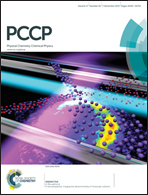Light harvesting in photonic crystals revisited: why do slow photons at the blue edge enhance absorption?†
Abstract
Light harvesting enhancement by slow photons in photonic crystal catalysts or dye-sensitized solar cells is a promising approach for increasing the efficiency of photoreactions. This structural effect is exploited in inverse opal TiO2 photocatalysts by tuning the red edge of the photonic band gap to the TiO2 electronic excitation band edge. In spite of many experimental demonstrations, the slow photon effect is not fully understood yet. In particular, observed enhancement by tuning the blue edge has remained unexplained. Based on rigorous couple wave analysis simulations, we quantify light harvesting enhancement in terms of absorption increase at a specific wavelength (monochromatic UV illumination) or photocurrent increase (solar light illumination), with respect to homogeneous flat slab of equivalent material thickness. We show that the commonly accepted explanation relying on light intensity confinement in high (low) dielectric constant regions at the red (blue) edge is challenged in the case of TiO2 inverse opals because of the sub-wavelength size of the material skeleton. The reason why slow photons at the blue edge are also able to enhance light harvesting is the loose confinement of the field, which leads to significant resonantly enhanced field intensity overlap with the skeleton in both red and blue edge tuning cases, yet with different intensity patterns.



 Please wait while we load your content...
Please wait while we load your content...